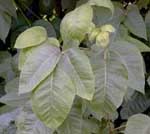Poison Ivy Control
Poison ivy (Toxicodendron radicans) is a woody
perennial shrub or vine that spreads by underground runners and by seeds. It
grows in all types of sod and under all conditions of sun and shade.
Protective Clothing
When working in or near poison-ivy, always wear protective clothing to ensure
that no area of the skin is exposed to the sap of the plant. Poison-ivy sap can
adhere for long periods to clothing, tools, and the hair coats of pets and
livestock. Under hot, humid conditions the sap becomes inactive in about a week.
If conditions are dry, it can retain its harmful effect for a long period.
Any clothing worn while working in or near
poison-ivy should be carefully removed, washed in hot, soapy water, and hung
outside to dry for several days. Remember to wear gloves while handling objects
that may be contaminated. Do not wash clothing suspected of contamination with
other laundry in order to avoid any further contamination. Repeated washing may
be
necessary.
Cultivation
For effective control of poison-ivy, the reproductive capacities of the plant
can be disrupted by destroying its roots and stems. By digging out and hand
picking the roots and stems, and working the soil frequently, the ability of the
plant to produce shoots will be minimized. Repeated cultivation will eventually
eliminate poison-ivy because the plant does not regenerate easily from plant
fragments. Since loose seeds may be difficult to detect, remove any dead plant
material from the ground in case some seeds are still attached to the stems.
Cautions
- Follow the label directions.
- Be very careful cutting down poison ivy; all
parts of the plant are poisonous.
- Even the dead plants are poisonous.
- Never burn them! Smoke and ash can carry
toxins to the skin causing a rash. Inhaling the smoke can be worse.
Identification
Each leaflet is oval-shaped, pointed at the tip, and tapered at the base. The
middle leaflet has a longer leaf stem than the two-sided ones. Leaflets may be
slightly lobed or coarsely toothed. The leaves' surfaces may be smooth or hairy,
glossy or dull. They can vary in color from yellowish-green and green to
reddish-green. Poison ivy fruits, which develop in fall, are small white berries
with sunken ribs. |
